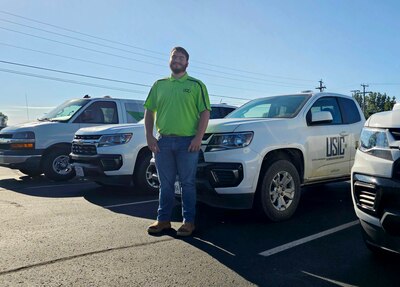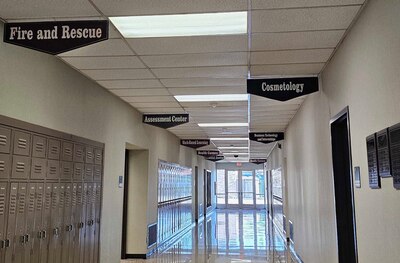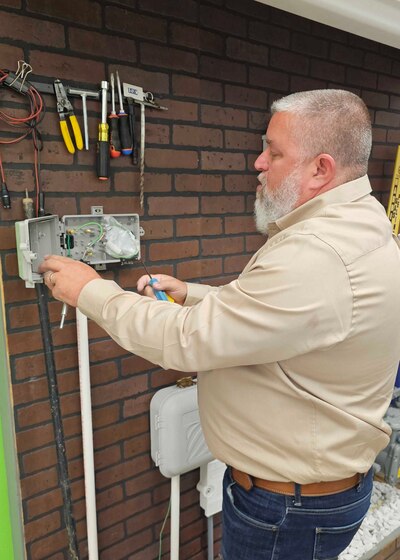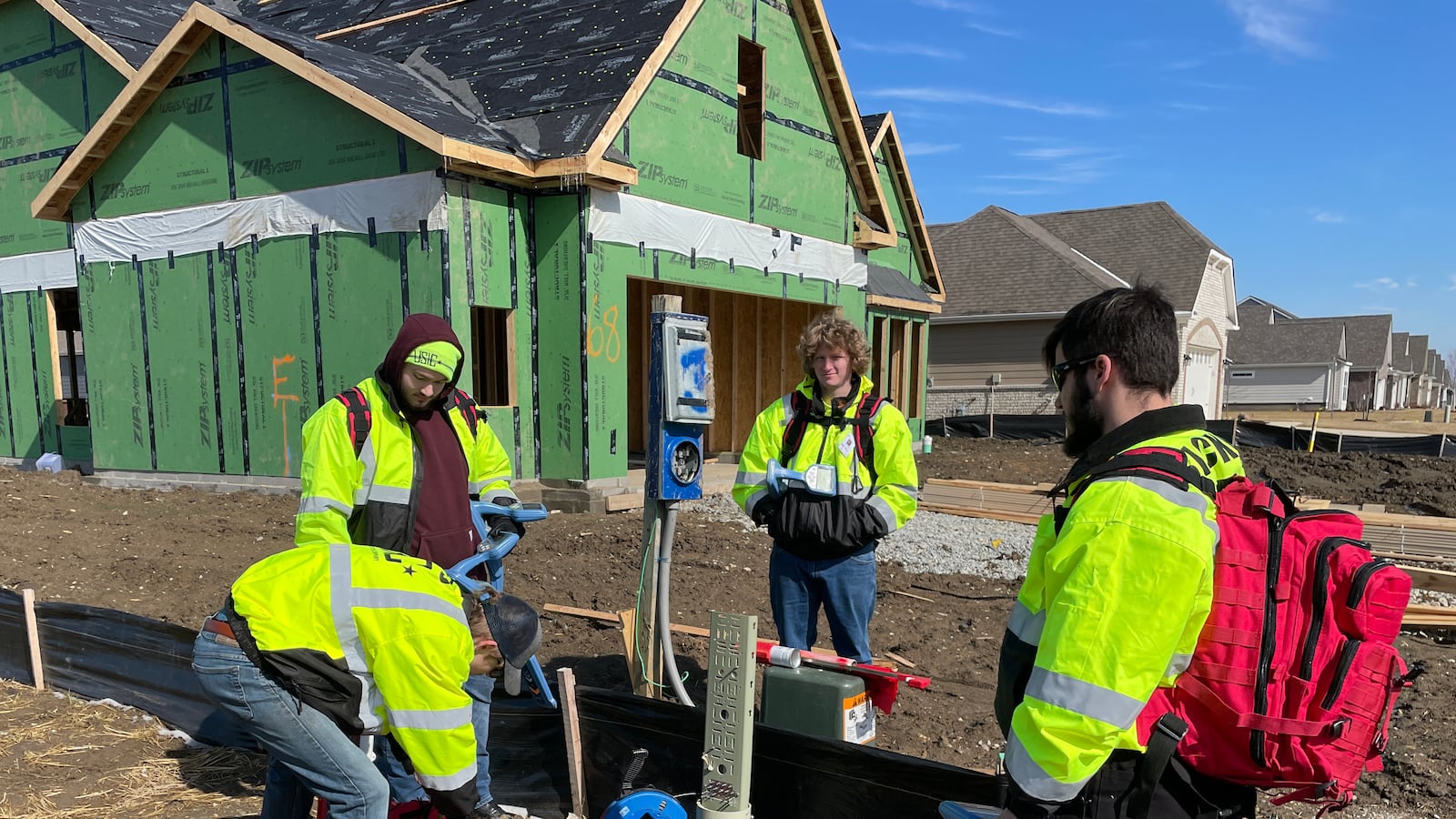Every now and then, Ayden Corbett has to explain to surprised homeowners what he’s doing in their front yard.
Since the second semester of his senior year of high school, he has responded to field calls as an employee of the largest underground utility locating company in North America — the Indianapolis-based U.S. Infrastructure Company (USIC). The white truck and multicolored flags marking the location of water, power, and telecommunications lines usually give it away.
“You learn how to work with people,” he said.
Corbett graduated in 2022 from a unique program at the Hinds Career Center in Elwood that trains high schoolers for the little-known underground utility locating industry. As demand for the profession skyrocketed during the work-from-home boom of the pandemic, USIC representatives approached the career center about creating a high school graduation pathway that would lead to a diploma, an industry certification, and a job offer.
While still uncommon in Indiana, partnerships between schools and private companies that lead students directly into employment in highly specific trades are growing — the Hinds Center program is the newest among four that have been started statewide.
“Their goal is to have trained employees ready to enter the field; ours as a career center is to give students the workforce and soft skills to be employable in whatever they choose,” said Jim Pearson, director of the Hinds center.
And creating more of these programs is a top priority for state education officials, who have been charged under a new state law with reworking high school requirements to encourage more students to work and earn credentials before they graduate.
It’s part of an effort to counter Indiana’s declining college going rates by connecting high school students to in-demand and high-paying jobs without the need for postsecondary education.

“Young people are really wanting a variety of options for leading to viable, successful futures. That’s not necessarily a four-year degree,” said Rachel Rosen, senior research associate at the Center for Effective Career and Technical Education at MRDC, a nonprofit, nonpartisan research organization.
‘Employable in whatever they choose’
The underground utility graduation track at the Hinds Center is a slower version of the standard company training program, hosted inside a former sewing classroom that USIC equipped with a virtual reality system and a wall showing the typical utility connections on a home. The company also provides the two instructors, said Darrin Haynes, senior manager of career and technical education at USIC.
Students study the underground utility maps of Indiana cities like Westfield, where new home construction is booming, and learn to use the equipment that allows them to detect underground utility lines both through virtual reality and in the field. They spend part of the day at the center for career training, but also take traditional academic courses at their home high schools.
USIC has hired 14 of the 16 graduates of the Elwood program over two years, and fielded calls from its competitors looking to hire students as well, Haynes said. As of this year, students will also earn college credit at Indiana Tech upon completing the pathway.
One of the main draws of the track is the opportunity to start working during senior year, said Jacob Wright, another 2022 grad. Students who are at least 18 years old are paid the same rate as new hires to respond to calls to 811, the service that companies and homeowners are supposed to call before digging projects, according to Haynes.
“You get a job out of high school, a (company) truck second semester, and you get paid to take calls,” said Wright.

Programs should connect to college and career
Several other local graduation pathways in Indiana offer students direct links to local companies, including the RV construction pathway at Wa-Nee Community schools, and a now-defunct aviation sheet metal pathway at Decatur schools.
The latter operated for a year before the pandemic created challenges for teaching and recruiting students, said Michael Gehrich, director of aviation at Vincennes University, which worked with Decatur schools on the pathway.
Like the utility locating program, the aviation pathway sought to expose students to a local industry that’s in need of workers, with a lower barrier to entry than existing dual credit aviation programs that require additional college education, Gehrich said.
Other similar programs can be found in New York City’s P-TECH schools, said Rosen, the researcher, which are six-year schools that partnered with companies to allow students to graduate with STEM skills, a high school diploma, and an associate’s degree.
Where vocational schools of the past contributed to inequity by directing low-income and students of color into low-wage jobs, modern career training can give students a window into their options, Rosen said.
“CTE in high school provides students an opportunity to explore what they don’t want to do as much as what they do want to do,” Rosen said. “We may see a failure because the student did not want to go into that field, but higher-resourced students have more opportunity to explore and make mistakes. If they wait till college to explore what they don’t like, there can be a real cost to doing that.”
The goal should be preparing students for a career with mobility, Rosen said.
Haynes said underground utility locating offers that mobility. Graduates can work for municipalities instead, move into management and training roles at USIC, or request to be relocated to another state.
The pathway opens a new option in a community where the college-going rate has dropped, said Haynes.

State data shows the rate for Madison County dropped 16 percentage points from 2015-2020, mirroring the state’s drop of 12 points in that time period.
Though no students have yet changed their minds about the senior-level course, Pearson said one advantage of the career center is that it has the flexibility to redirect students to one of its other career paths.
Plans to expand in Indiana and other states
Pearson said the Hinds center is open to working with other companies to develop local graduation pathways and meet workforce needs — but that they would need to work closely with educators on curriculum and standards.
The career center would aim to stay away from low-skill, low-pay tracks, but wouldn’t outright reject retail pathways, for example, if they led into supervision and management positions, Pearson said.
Haynes said that other companies interested in creating their own pipeline programs at local high schools need to commit to an upfront investment with a slow return. In addition to a workforce pipeline, one major benefit to USIC is that graduates have more time to absorb the training, and begin working with more experience, often making fewer mistakes than other new hires.
Haynes said the company isn’t working with students who are using Indiana’s new career scholarship accounts, which give students money to take career training outside of their schools. Those students could apply for a job with the company and take the training there, he siad.

The company plans to continue recruiting in high schools. Haynes said USIC has replicated the high school training program in Oklahoma and New York, and hopes to grow it further throughout Indiana and other states.
“Most of our graduates have moved out, have a place of their own. They start their lives in a way that we all dream of when we’re teenagers,” said Haynes. “We’re putting them on a pathway to do that.”
Aleksandra Appleton covers Indiana education policy and writes about K-12 schools across the state. Contact her at aappleton@chalkbeat.org.

